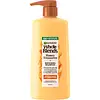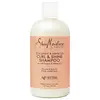What's inside
What's inside
 Key Ingredients
Key Ingredients

 Benefits
Benefits

 Concerns
Concerns

 Ingredients Side-by-side
Ingredients Side-by-side

Water
Skin ConditioningSodium Laureth Sulfate
CleansingSodium Lauryl Sulfate
CleansingCocamide Mea
EmulsifyingGlycol Distearate
EmollientSodium Chloride
MaskingMel
EmollientPPG-5-Ceteth-20
EmulsifyingArgania Spinosa Kernel Oil
EmollientFumaric Acid
BufferingRoyal Jelly
Carbomer
Emulsion StabilisingGlycerin
HumectantDimethicone
EmollientAloe Barbadensis Leaf Juice
Skin ConditioningSodium Hydroxide
BufferingAlcohol
AntimicrobialPropolis Extract
Skin ConditioningGuar Hydroxypropyltrimonium Chloride
Skin ConditioningCitric Acid
BufferingSodium Benzoate
MaskingSalicylic Acid
MaskingCI 19140
Cosmetic ColorantCaramel
Cosmetic ColorantParfum
MaskingCoumarin
PerfumingLimonene
PerfumingBenzyl Alcohol
PerfumingBenzyl Salicylate
PerfumingFish Oil
Skin ConditioningCeramide AP
Skin ConditioningWater, Sodium Laureth Sulfate, Sodium Lauryl Sulfate, Cocamide Mea, Glycol Distearate, Sodium Chloride, Mel, PPG-5-Ceteth-20, Argania Spinosa Kernel Oil, Fumaric Acid, Royal Jelly, Carbomer, Glycerin, Dimethicone, Aloe Barbadensis Leaf Juice, Sodium Hydroxide, Alcohol, Propolis Extract, Guar Hydroxypropyltrimonium Chloride, Citric Acid, Sodium Benzoate, Salicylic Acid, CI 19140, Caramel, Parfum, Coumarin, Limonene, Benzyl Alcohol, Benzyl Salicylate, Fish Oil, Ceramide AP
Water
Skin ConditioningDecyl Glucoside
CleansingSodium Lauroyl Lactylate
EmulsifyingGlycol Stearate
EmollientParfum
MaskingButyrospermum Parkii Butter
Skin ConditioningPanthenol
Skin ConditioningGuar Hydroxypropyltrimonium Chloride
Skin ConditioningSodium Lauroyl Hydrolyzed Silk
Skin ConditioningCitric Acid
BufferingStearamide Amp
Melia Azadirachta Seed Oil
EmollientBrassica Campestris Seed Oil
Skin ConditioningSodium Phytate
Cocos Nucifera Oil
MaskingRosmarinus Officinalis Leaf Oil
MaskingTocopherol
AntioxidantHibiscus Rosa-Sinensis Flower Extract
HumectantAloe Barbadensis Leaf Juice
Skin ConditioningGlycerin
HumectantGlycine Soja Oil
EmollientSodium Benzoate
MaskingCaprylyl Glycol
EmollientTriethyl Citrate
MaskingBenzoic Acid
MaskingWater, Decyl Glucoside, Sodium Lauroyl Lactylate, Glycol Stearate, Parfum, Butyrospermum Parkii Butter, Panthenol, Guar Hydroxypropyltrimonium Chloride, Sodium Lauroyl Hydrolyzed Silk, Citric Acid, Stearamide Amp, Melia Azadirachta Seed Oil, Brassica Campestris Seed Oil, Sodium Phytate, Cocos Nucifera Oil, Rosmarinus Officinalis Leaf Oil, Tocopherol, Hibiscus Rosa-Sinensis Flower Extract, Aloe Barbadensis Leaf Juice, Glycerin, Glycine Soja Oil, Sodium Benzoate, Caprylyl Glycol, Triethyl Citrate, Benzoic Acid
Ingredients Explained
These ingredients are found in both products.
Ingredients higher up in an ingredient list are typically present in a larger amount.
Aloe Barbadensis Leaf Juice comes from leaves of the aloe plant. Aloe Barbadensis Leaf Juice is best known for helping to soothe sunburns. It is also anti-inflammatory, moisturizing, antiseptic, and can help heal wounds.
Aloe is packed with good stuff including Vitamins A, C, and E. These vitamins are antioxidants, which help fight free-radicals and the damage they may cause. Free-radicals are molecules that may damage your skin cells, such as pollution.
Aloe Barbadensis Leaf Juice also contains sugars. These sugars come in the form of monosaccharides and polysaccharides, folic acid, and choline. These sugars are able to help bind moisture to skin.
It also contains minerals such as calcium, 12 anthraquinones, fatty acids, amino acids, and Vitamin B12.
Learn more about Aloe Barbadensis Leaf JuiceCitric Acid is an alpha hydroxy acid (AHA) naturally found in citrus fruits like oranges, lemons, and limes.
Like other AHAs, citric acid can exfoliate skin by breaking down the bonds that hold dead skin cells together. This helps reveal smoother and brighter skin underneath.
However, this exfoliating effect only happens at high concentrations (20%) which can be hard to find in cosmetic products.
Due to this, citric acid is usually included in small amounts as a pH adjuster. This helps keep products slightly more acidic and compatible with skin's natural pH.
In skincare formulas, citric acid can:
While it can provide some skin benefits, research shows lactic acid and glycolic acid are generally more effective and less irritating exfoliants.
Most citric acid used in skincare today is made by fermenting sugars (usually from molasses). This synthetic version is identical to the natural citrus form but easier to stabilize and use in formulations.
Read more about some other popular AHA's here:
Learn more about Citric AcidGlycerin is already naturally found in your skin. It helps moisturize and protect your skin.
A study from 2016 found glycerin to be more effective as a humectant than AHAs and hyaluronic acid.
As a humectant, it helps the skin stay hydrated by pulling moisture to your skin. The low molecular weight of glycerin allows it to pull moisture into the deeper layers of your skin.
Hydrated skin improves your skin barrier; Your skin barrier helps protect against irritants and bacteria.
Glycerin has also been found to have antimicrobial and antiviral properties. Due to these properties, glycerin is often used in wound and burn treatments.
In cosmetics, glycerin is usually derived from plants such as soybean or palm. However, it can also be sourced from animals, such as tallow or animal fat.
This ingredient is organic, colorless, odorless, and non-toxic.
Glycerin is the name for this ingredient in American English. British English uses Glycerol/Glycerine.
Learn more about GlycerinThis ingredient is derived from guar gum.
It is a conditioning ingredient, meaning it helps soften skin and hair.
Parfum is a catch-all term for an ingredient or more that is used to give a scent to products.
Also called "fragrance", this ingredient can be a blend of hundreds of chemicals or plant oils. This means every product with "fragrance" or "parfum" in the ingredients list is a different mixture.
For instance, Habanolide is a proprietary trade name for a specific aroma chemical. When used as a fragrance ingredient in cosmetics, most aroma chemicals fall under the broad labeling category of “FRAGRANCE” or “PARFUM” according to EU and US regulations.
The term 'parfum' or 'fragrance' is not regulated in many countries. In many cases, it is up to the brand to define this term.
For instance, many brands choose to label themselves as "fragrance-free" because they are not using synthetic fragrances. However, their products may still contain ingredients such as essential oils that are considered a fragrance by INCI standards.
One example is Calendula flower extract. Calendula is an essential oil that still imparts a scent or 'fragrance'.
Depending on the blend, the ingredients in the mixture can cause allergies and sensitivities on the skin. Some ingredients that are known EU allergens include linalool and citronellol.
Parfum can also be used to mask or cover an unpleasant scent.
The bottom line is: not all fragrances/parfum/ingredients are created equally. If you are worried about fragrances, we recommend taking a closer look at an ingredient. And of course, we always recommend speaking with a professional.
Learn more about ParfumSodium Benzoate is a preservative. It's used in both cosmetic and food products to inhibit the growth of mold and bacteria. It is typically produced synthetically.
Both the US FDA and EU Health Committee have approved the use of sodium benzoate. In the US, levels of 0.1% (of the total product) are allowed.
Sodium benzoate works as a preservative by inhibiting the growth of bacteria inside of cells. It prevents the cell from fermenting a type of sugar using an enzyme called phosphofructokinase.
It is the salt of benzoic acid. Foods containing sodium benzoate include soda, salad dressings, condiments, fruit juices, wines, and snack foods.
Studies for using ascorbic acid and sodium benzoate in cosmetics are lacking, especially in skincare routines with multiple steps.
We always recommend speaking with a professional, such as a dermatologist, if you have any concerns.
Learn more about Sodium BenzoateWater. It's the most common cosmetic ingredient of all. You'll usually see it at the top of ingredient lists, meaning that it makes up the largest part of the product.
So why is it so popular? Water most often acts as a solvent - this means that it helps dissolve other ingredients into the formulation.
You'll also recognize water as that liquid we all need to stay alive. If you see this, drink a glass of water. Stay hydrated!
Learn more about Water